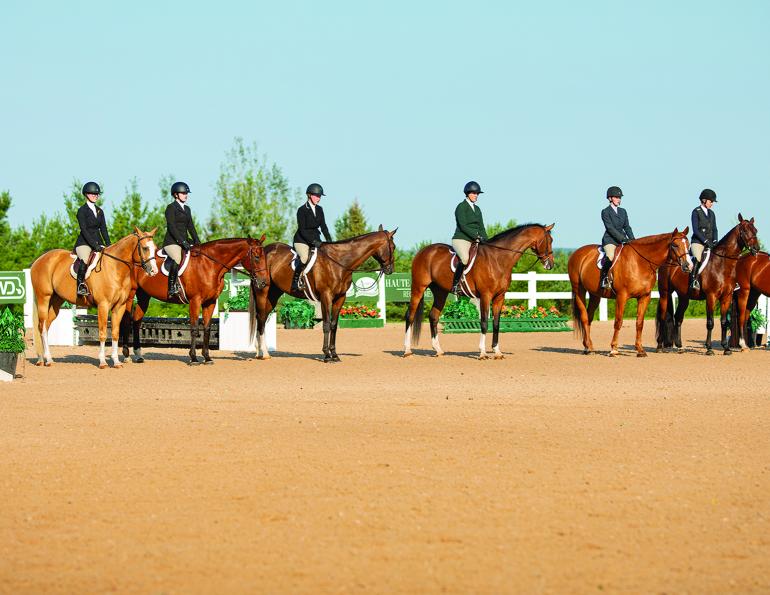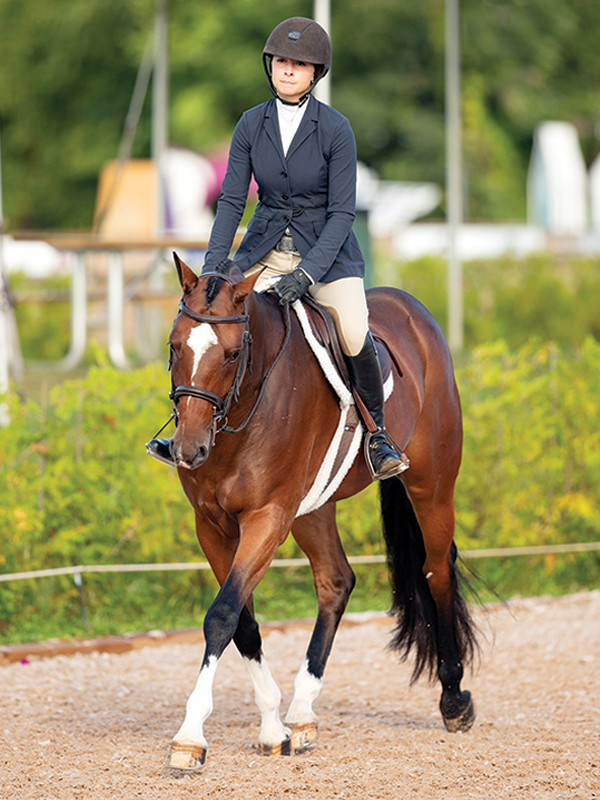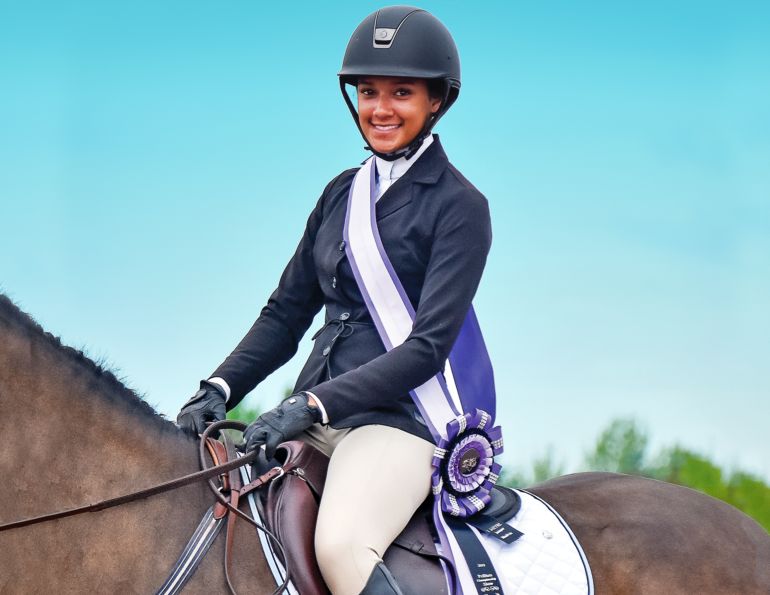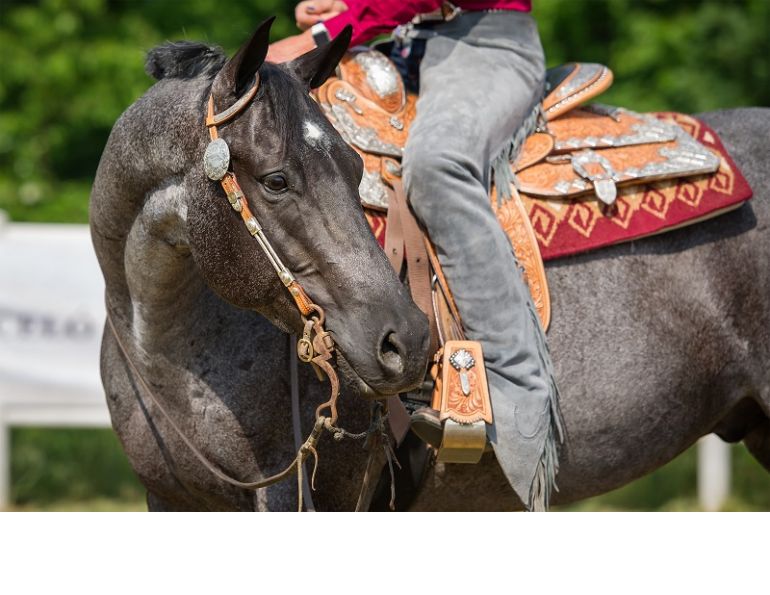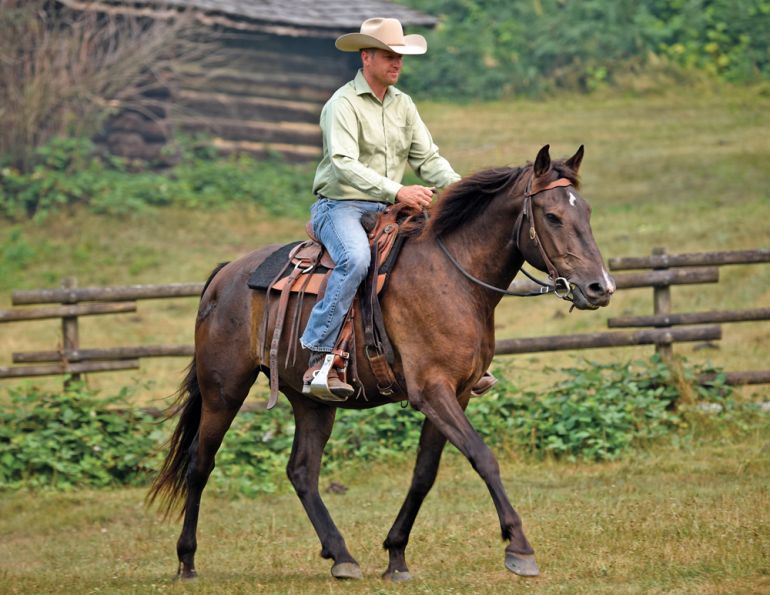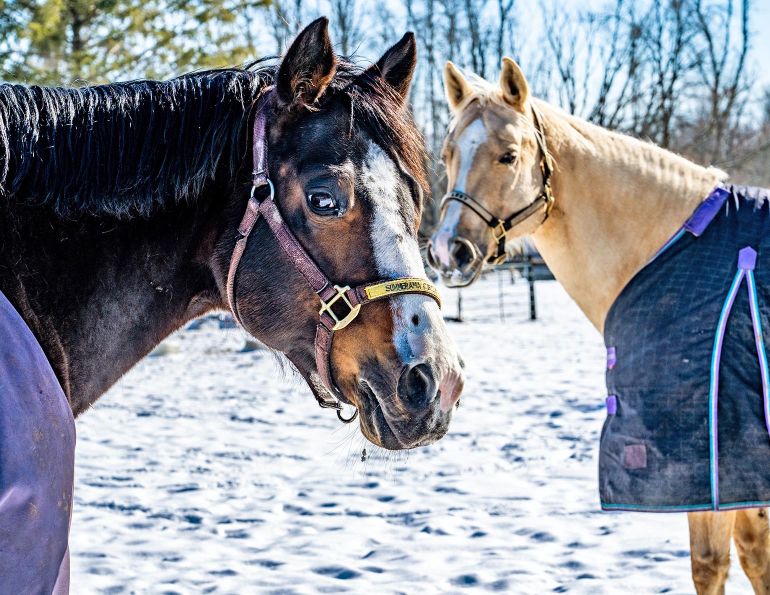Riding the Rail
By Lindsay Grice, Equestrian Canada coach and judge
No jumps. No pylons. No letter markers. Unlike classes assessing the accuracy of patterns, the quality of movements in tests, or how the competitor meets each jump on course, flat or rail classes appraise the picture of you and your horse in profile.
Flat classes are the most subjectively judged of horse show events. Without the numerical scoring systems of other disciplines, the judge has more latitude for their preferences. Still, there’s more to the sorting process than The judge just didn’t like my horse.
Most judges employ a hierarchy of attributes to sort entries:
- Correctness – Is the competitor functionally sound and conforming to the rules? The judge will consider correct leads, diagonals, and gait rhythms.
- Quality – Is the entry pleasing to the eye, with self-carriage and well turned out?
- Degree of difficulty – Is there an eye-catching specialness separating an entry from the pack, an element of risk or creativity?
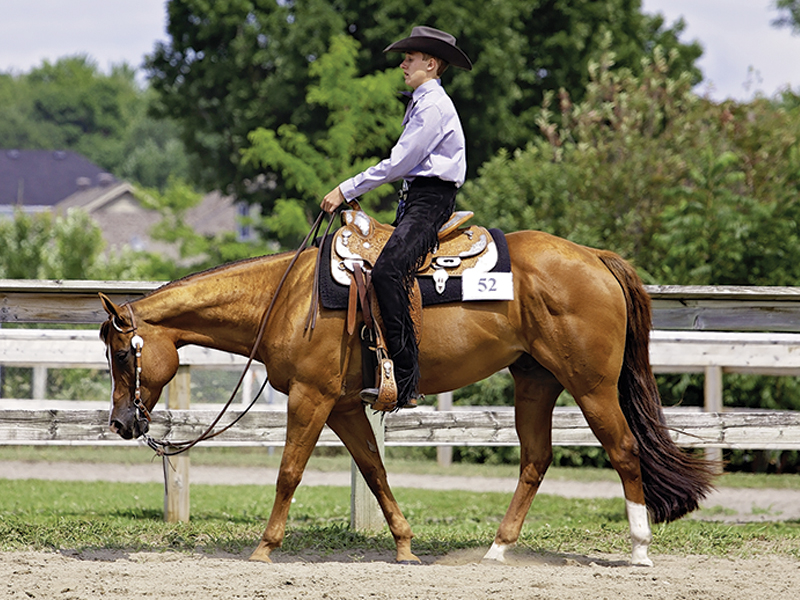
Flat or rail classes evaluate the picture of you and your horse in profile. Prepare by learning how to navigate the arena and present a horse well by accentuating a horse’s best qualities while minimizing lesser attributes. Photo: Epona Portraits & Public Relations
What’s the Judge Looking For?
When I entered my first show, I didn’t know the difference between Equitation and Hunter Under Saddle. I paid the entry, followed the announcer’s instructions, but failed to read the rule book.
Now, I encourage the riders I coach to mine the rule book for more than the rules. In it you’ll find treasures such as the purpose of each class, as well as words and phrases describing poor, correct, and exceptional movement.
As a professional trainer, Hunter Under Saddle became my favourite class. What I’ve learned in the show ring I pass on to my students in terms of navigating the arena and the artistry of presenting a horse well. I learned to uncover and accentuate a horse’s best qualities while minimizing their lesser attributes.
What’s the point of this class? When judging, I survey the group of horses moving around the ring and visualize the ideal — the entry illustrating the original intent of the class. Could that Hunter Under Saddle effortlessly jump a course? Would that Road Hack fit the hunt field? Is that Horsemanship rider not only elegant, but effective? Is that Pleasure Hack truly a pleasure to ride?
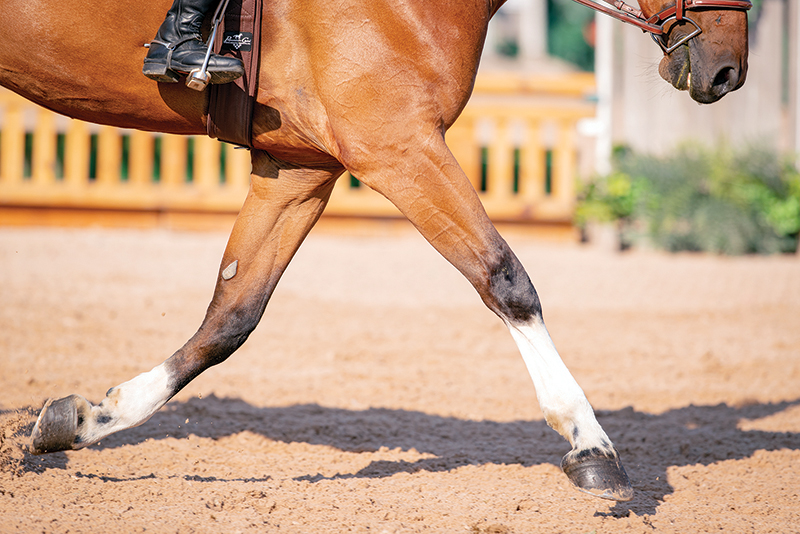
Be prepared for the gait requirements in your class. Western Pleasure horses may be asked for a moderate extension of the jog. In the Road Hack class, gaits include strong trot and hand gallop. Show hacks are asked to show extension and collection at all gaits. Photo: Ringside Media
Clues in the Descriptions
Let the adjectives and adverbs from your rule book guide you. Matching your horse to the description is one part training and one part aptitude.
- The Hunter Under Saddle takes long, sweeping, deliberate strides extending from his shoulder. His hocks swing forward to step into his front footprints. His self-carriage is evidenced by light, relaxed contact. In contrast, the animated “on-the-muscle” horse, moving in up-and-down motion, may suit other classes but not Hunter Under Saddle.
- The Western Pleasure winner lopes slow-legged with a steady relaxed topline. Each stride has lift — a moment of suspension — flowing consistently into the next stride. Yet, Western Pleasure is not a contest of slow. Trying too hard not to pass typically manufactures a head-bobbing, laboured stride, or scuttling along in a four-beat lope.
- The Hack division consists of three classes, the ideals of which vary somewhat. Show Hacks display vitality and animation, adjusting between extended and collected gaits. Road Hacks have the strength and substance of a field hunter. Pleasure Hacks are a smooth and sensible ride.
- Equitation on the Flat assesses the rider’s position, poise, and effectiveness at all gaits in both directions. Though the horse itself isn’t being judged, how it performs will influence how the rider looks. Savvy “equitators” discern the balance between poise and pose. Poise is to be secure, yet supple. Trying too hard looks stiff and starchy.
- Western Horsemanship evaluates the exhibitor’s balanced, functional, and correct position, regardless of the gait being performed. The Western position is foundationally the same as for English equitation — long leg, deep heel, flat and supple back. The subtle cueing of winning Horsemanship calls for more rein connection than the Western Pleasure drape, guiding the horse with no more than slight hand movement.
Related: How to Ride Better by Thinking Less
In flat classes without a pattern or obstacle to keep your horse from becoming distracted, his ears are a good indicator of where his attention is focused. Photo: Ringside Media
Play by the Rules
As they enter the gate, judges scan each competitor for permitted equipment. What’s allowed and what’s not depends on the class and governing association. In general, no martingales are permitted on the flat. No boots for classes in which your horse’s movement is assessed. No crops in the Hack division.
Judging smaller shows, I often alert Western competitors to misplaced curb chains. Occasionally, English riders forget to remove their protective boots or martingales before the flat phase.
Be prepared for the gait requirements in your particular class. Western Pleasure horses may be asked for a moderate extension of the jog. Road Hack gaits include strong trot and hand gallop. Show Hacks must be ready to extend and collect all gaits.
Every discipline has its unwritten rules. For example, in AQHA Hunter Under Saddle, riders canter in full seat and will always be asked to rein-back. In hunter/jumper shows, exhibitors canter their Hunter Under Saddle in two-point or light seat and are never asked to rein-back.
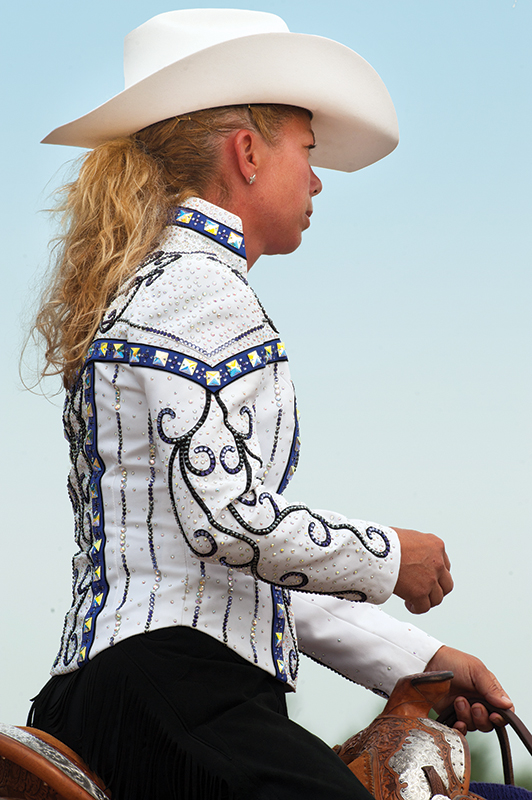
Enter the ring with confidence and make a good first impression. Photo: Clix Photography
Use Those Teachable Moments
You’re always training (or untraining) your horse, setting patterns (intentionally or not) that your horse begins to anticipate. So, mix up the routine. Avoid stopping at the gate. Ensure your horse takes his cues from you, not the announcer, the environment, or the flow of his ring-mates. Because you share the judge’s attention with other competitors in the ring, you can sneak in some show ring training tidbits when the judge’s eyes aren’t glued to you. Use your corners or changes of direction to connect with your horse.
First impressions, lasting impressions. Enter the ring with confidence — in show mode, not training mode. Though judges aren’t yet officially scoring, they’re forming opinions as they organize bookwork and check tack. Get in there promptly. Don’t dilly-dally and contribute to a delay, which is irritating to the judge you’re hoping to impress. As a bonus, making an early entrance carves out extra warmup time while the judge is recording numbers… and waiting for the tardy entries.
Undistracting turnout. Do judges care if…? Do judges prefer…? Judging has taught me that the pressure to sort through a group of moving horses in a limited time doesn’t leave room for pet preferences. Without a good mover and correct leads, bling and brand names won’t land anyone in the ribbons.
My best advice? Just don’t be distracting — avoid wispy hair, a flapping number, anything untailored or unkempt. Do not use unconventional tack, prompting the judge to take a second look. Mentally rehearse the rule book and ask yourself – Gee, is that (noseband / bit / leather item) permitted in this class?
Undistracting equitation. Don’t make the judge mentally block out your position to focus on your horse. The art of exhibiting is to enhance your horse’s stride with subtle, almost invisible corrections while making him look effortless to ride.
Related: When Things Go Wrong in the Show Ring
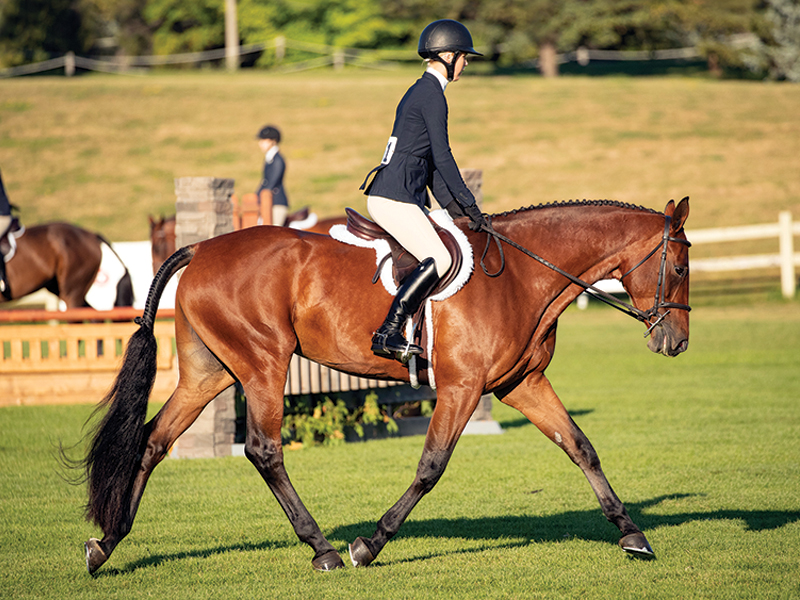
The art of exhibiting is to enhance your horse’s stride with subtle corrections while making him look effortless to ride. Photo: Ringside Media
Do what you’re asked. Though there’s no need to take off like a shot, transition as promptly as possible into the announced gait. Delayed transitions are annoying to the judge and to the competitor behind you. If the judge asks for extension of the jog in Western Pleasure, move up noticeably. For extended and collected gaits, make an effort to show clear differences in stride length and frame.
Show your best stuff. In individually worked classes, there’s nowhere to hide. Classes judged in a group afford some margin to display your best and camouflage your worst. Canter and lope are the deal breakers. If that’s your horse’s better gait, lucky you — get out on the inside track and show it off. If your sitting trot is a work in progress, hunt the outside track. If your lope transition is still rusty and the gait is called while you’re smack in front of the judge, delay liftoff as long as possible (without being annoying). With extra seconds to gather your horse up, you’re less likely to spill into a mess or even a wrong lead.
Graceful recovery. If you do land a wrong lead, don’t panic. Just reorganize and ask for the transition again… a little more carefully. As a judge, I don’t want to catch mistakes. I want to reward the best horse and rider. However, I can’t unsee slip-ups. Spook, stumble, or lose a stirrup? Regroup and carry on confidently as if nothing happened.
Maximize your horse’s stride. Nervous riders hold their breath, hindering flow. English or Western riders’ arms should be elastic and joints supple, following the motion of the stride. Posting slow and long sets a metronome for the slow-legged mover to match.
Equitation exhibitors maintain rein contact. In contrast, softer rein connection (reasonably straight with just a little bit of movement) shows off the steadiness of your Hunter Under Saddle or Pleasure Hack. Rein-swinging gaits demonstrate that your Western Pleasure horse rides on auto pilot. To me, however, excessive drape looks sloppy.
Be visible. A judge can’t place you if you can’t be seen. I can attest — it’s far easier to evaluate physically distanced entries than to sift through the overlapping legs of a herd in front of me to find the best mover. Circling to keep out of traffic was fine for the riding school, but not for the show ring. Instead, keep the pack of horses behind you by cutting the next corner. Alternatively, ride deep into a corner to let others pass by.
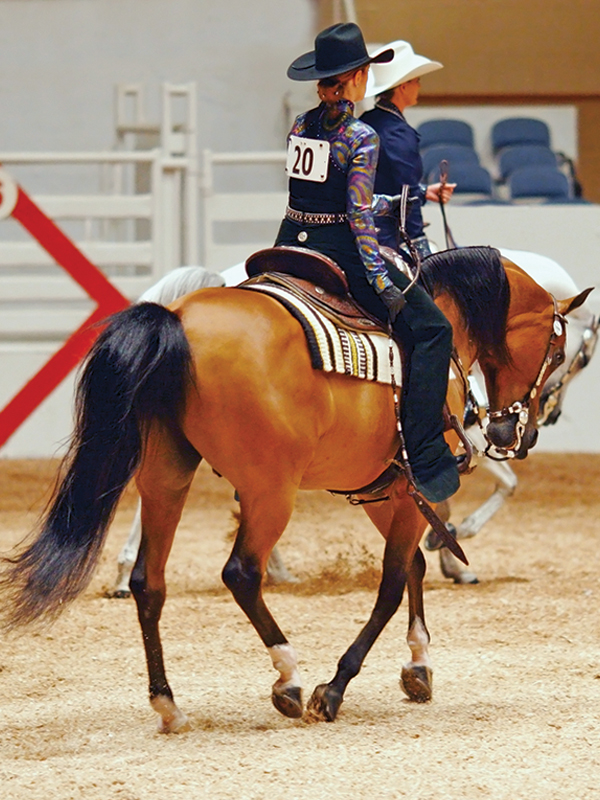
Staying visible makes it easier for the judge to evaluate you and your horse. Navigate ring traffic well to maximize your horse’s expression and protect his confidence. Photo: Shutterstock/Victoria Short
Don’t overdo it. Trying to catch the judge’s attention by monopolizing the inside track is irritating and blocks his view of the others.
If your discipline permits, opt for a saddle pad displaying your entry numbers on both sides, rather than numbers pinned or tied to the back — what a gift for judges! If string’s the thing in your discipline, don’t wait until you’re asked to slide your back number visibly to the inside.
Defensive driving. Getting caught in a traffic jam makes anyone grumpy. Grumpy is not a winning look. Maximize your horse’s expression and protect his confidence. A brush with an unruly entry, kicking out, or passing on the outside is not easily forgotten. Give such horses a wide berth — unruly is contagious.
Don’t be the source of the problem. Keep your horse focused on you. Distraction is amplified in a flat class without jumps, obstacles, or a pattern to keep your horse occupied. An idle mind is the devil’s workshop. Monitor your horse’s ears — they’re a good indicator of where his attention is directed.
The winners of group classes are announced from the lineup, pageant style. “And the winner is…” May that number be yours!
Related: The Many Hats of a Horse Show Judge
Main Photo: Ringside Media



